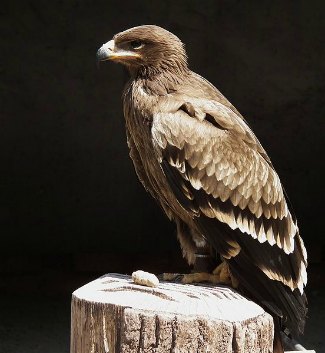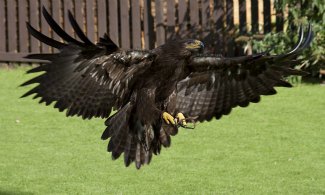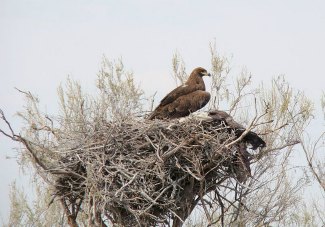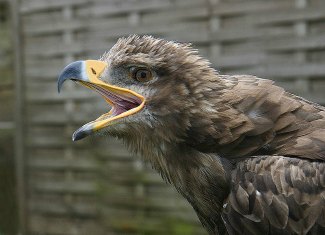Steppe Eagle - Aquila nipalensis
By 4028mdk09, CC-BY-SA-3.0, via Wikimedia Commons
Family: Acciptridae
Genus: Aquila
Species: A. nipalensis
Subspecies: A. n. nipalensis, A. n. orientalis
Steppe Eagles are medium-sized, migratory eagles that occur in Europe, Asia, and Africa. They form a clade with Aquila adalberti (Spanish Imperial Eagle), A. heliaca (Eastern Imperial Eagle), and A. rapax (Tawny Eagle).
Physical Description:
Steppe Eagles are brown with dark wing coverts, barring along the flight feathers and tail, and pale-tipped secondary feathers. They have a gray patch on the primary feathers and there are 7-8 black bars on the underwing. The legs are feathered. The head is small relative to their body size, and they have a large beak. Nominate subspecies A. n. nipalensis is larger than A. n. orientalis and has a buff to rufous patch on the nape and crown. Adults from either subspecies may be confused with Aquila clanga (Greater Spotted Eagle) or Aquila pomarina (Lesser Spotted Eagle), but A. nipalensis is larger than both and has a longer gape-flange and wings.
Juveniles are brown to gray-brown and they have a buff-rufous patch on the nape. The wing-coverts, wings, and tail are black with white tips, while the uppertail covers are white. They have a white band along the underside of the wing. Juveniles reach full adult plumage after 5-6, sometimes 7 years.
Overall, Steppe Eagles are quiet birds. Their calls include a loud whistle, croaks, and a high-pitched shriek when alarmed.
They can live up to 41 years in captivity.
Size:
Length: 60-81 cm
Wingspan: 165-214 cm
Weight: A. n. nipalensis: Male: 2.5-3.5 kg. Female: 2.3-4.9 kg. A. n. orientalis: Male: 2.0-3.1 kg.
Female: 2.3-3.9 kg.
By Tony Hisgett, CC-BY-2.0, via Wikimedia Commons
Habitat and Distribution:
They inhabit desert, semi-desert, open savannah, grassland, open woodland, cultivated areas, and as their name would indicate, steppes. They are found from 0-3,000 m above sea level, though they have been recorded as high as 7,900 m in Nepal and at 4,500+ meters while on migration. They roost on the ground, in trees, and on power poles, and during the winter they congregate in groups up to the hundreds, sometimes with other species such as Milvus migrans (Black Kite) or Aquila pomarina (Lesser Spotted Eagle).
They breed in southeastern Russia, central Asia, eastern Kazakhstan, the Altai Mountains, Tibet, and northeastern China, from 67°N to 35°N. Their wintering grounds are in the Middle East, the Arabian Peninsula, the Indian subcontinent, southern China, and southeast Asia, from 35°N to 28°S. They are complete long distance migrants and the entire population moves south in October; they return in January-February. Groups of up to 400 eagles have been recorded and the population as a whole is thought to be around 10,000 individuals.
Diet and Hunting:
They eat a range of prey, such as mammals, birds, reptiles, insects, and carrion, usually from 50-250 g in weight. Western populations specialize in susliks (in particular, Spermophilus pygmaeus), which can consist of up to 98% of their diet, and in Mongolia a majority of their diet is Brandt’s Voles (Lasiopodomys brandtii).
By Yuriy75, CC-BY-SA-3.0, via Wikimedia Commons
Almost all of their prey is taken on the ground, and they hunt using a range of methods. Small animals and insects are sometimes stalked on the ground; locusts are taken during swarms; they occasionally forage in flight up to 200 m high, diving to catch their food; and they are known to fly above or below another bird until it's forced to drop its prey, thereby allowing the eagles to steal the food it was carrying.
Reproduction:
The breeding season is from April-August. Pairs can have territories from 4.5-54 km² in size.
The nest is built out of sticks and is usually 0.7-1.0 m across and 50 cm deep. It is lined with twigs and refuse, including bones, feathers, and dung, and placed in an exposed location in a low bush, tree, power pole, cliff, or even an abandoned car. 2 eggs are laid, though clutch size ranges from 1 all the way to 5, the latter of which has been recorded twice. The eggs are white with yellow-brown markings and incubated for 45 days. Fledging takes 55-65 days, and it is not uncommon for 2-3 young to successfully fledge at one time.
Conservation:
Steppe Eagles are under threat from habitat loss, persecution, predation of chicks, and electrocution or injury from power lines. Despite a declining population, they are currently listed as Least Concern by BirdLife International.
By Petra & Wilfred, CC-BY-2.0, via Wikimedia Commons
Taxonomy:
Aquila nipalensis was formerly considered part of species Aquila rapax (Tawny Eagle) by several authorities. However, based on morphological, ecological, and behavioral differences the two species have been split and DNA sequencing of one mitochondrial and three nuclear genes have shown that they do not even form a superspecies.
Sequencing of one nuclear and two mitochondrial genes has indicated that A. nipalensis forms a clade with Aquila adalberti (Spanish Imperial Eagle), A. heliaca (Eastern Imperial Eagle), and A. rapax (Tawny Eagle).
Subspecies:
There are two subspecies: A. n. nipalensis is found in the Altai Mountains, Tibet, northeast China, and Mongolia during the breeding season, and migrates south to southern Asia. A. n. orientalis breeds in southeast Europe, southern Russia, and Central Asia and winters in the Middle East, the Arabian Peninsula, and eastern and southern Africa.
Other Names:
Oriental Steppe Eagle, Orel stepní (Czech), Steppeørn (Danish), Steppearend (Dutch), Arokotka (Finnish), Aigle des steppes (French), Steppenadler (German), Pusztai sas (Hungarian), Steppuörn (Icelandic), Aquila delle steppe (Italian), Sougenwashi (Japanese), Helang Padang (Malay), Steppeørn (Norwegian), Orzel stepowy (Polish), Águila Esteparia (Spanish), Tai-nyika (Swahili), Stäppörn (Swedish).
Video of a Steppe Eagle:
References:
http://www.arkive.org/steppe-eagle/aquila-nipalensis/
http://avibase.bsc-eoc.org/species.jsp?avibaseid=A635F56542EE0C16
http://www.birds.kz/species.php?species=103&l=en
BirdLife International (2012) Species factsheet: Aquila nipalensis. Downloaded from http://www.birdlife.org on 04/04/2012.
http://blx1.bto.org/birdfacts/results/bob2942.htm
http://www.europeanraptors.org/raptors/steppe_eagle.html
Global Raptor Information Network. 2012. Species account: Steppe Eagle Aquila nipalensis. Downloaded from
http://www.globalraptors.org on 4 Apr. 2012
http://ibc.lynxeds.com/species/steppe-eagle-aquila-nipalensis
http://www.kenyabirds.org.uk/steppe.htm
BirdLife International 2011. Aquila nipalensis. In: IUCN 2011. IUCN Red List of Threatened Species. Version 2011.2.
www.iucnredlist.org. Downloaded on 04 April 2012.
http://www.planetofbirds.com/accipitriformes-accipitridae-steppe-eagle-aquila-nipalensis
Ferguson-Lees, James, and Christie, David A. Raptors of the World. Houghton Mifflin Company, 2001.
http://www.waza.org/en/zoo/visit-the-zoo/birds-of-prey-1254385523/aquila-nipalensis



